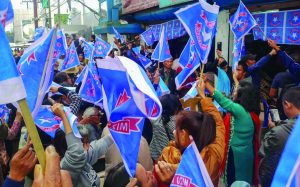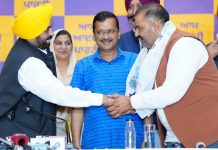 As predicted the last bastion of Congress in northeast India has fallen and its rival Mizo National Front (MNF) emerged victorious. After two consecutive terms, the ruling Congress faced tough challenges from the MNF in the Assembly elections held on 28 November and finally lost its claim, paving the way for emerging a ‘Congress Rule Free Northeast’ since the independence.
As predicted the last bastion of Congress in northeast India has fallen and its rival Mizo National Front (MNF) emerged victorious. After two consecutive terms, the ruling Congress faced tough challenges from the MNF in the Assembly elections held on 28 November and finally lost its claim, paving the way for emerging a ‘Congress Rule Free Northeast’ since the independence.
The Assembly polls outcome, which was declared on 11 December, also brought smile to the Bhartiya Janata Party (BJP), which has opened the account with a seat for the first time in the frontier State, bordering Myanmar in the east and Bangladesh in the west. And finally the saffron party has fulfilled its dream to erase the Congress rule from all eight States of the region, which was otherwise identified as a stronghold for the oldest party of India.
Pu Zoram Thanga led MNF won 26 seats in the 40-member State Legislative Assembly, where the former chief minister recorded victory from Aizawl East Assembly constituency paving the way to become the next chief minister of Mizoram. An insurgent leader turned politician Zoram Thanga maintained that the MNF would continue its alliance with the BJP led National Democratic Alliance at the Centre.
Pu Lalthanhawla led Congress has been restricted into five seats only. Even the five-time chief minister Lalthanhawla lost in two seats namely Champhai South and Serchhip Assembly constituency. In the outgoing Assembly, the Congress had 34 legislators, where MNF had only five members. Significantly there was only one lady legislator (of Congress) in the Assembly and this time no woman candidate could win the electoral battle.
The picturesque State has already earned appreciations for the remarkably peaceful elections, where over 80 percent electorate out of over 7,70,000 voters exercised their franchise through electronic voting machines (EVM) in a free & fair atmosphere. Need not to mention that Mizoram is recognized as one of the most peaceful and literate States in the country, where most residents can understand and even speak English.
Mostly covered by hilly terrains, the State with an area of around 21,087 square kilometers has around 10 lakh population where 60 per cent of them are dependent on agriculture, mostly the Jhum (slash & burn) cultivation. It is almost a homogenous society as 94 per cent of Mizoram residents are tribal and over 80 percent is Christian with few minority communities including Chakma and Bru.
The State has more women electorate (3,94,897) than their male counterparts. As per the 2011 Census, Mizoram recorded 976 females per 1,000 males (better than the national statistic of 943 per 1,000). But amazingly, even though there is more women voters, very few female candidates come forward to participate in the polls.
Surprisingly various political parties also avoid their candidatures. This time only 15 women were offered party tickets out of over 200 candidates. The BJP nominated highest number (six) of women candidates, where as the Congress put only one candidate. The MNF list was out of any woman candidate. Zoram Thar forwarded five lady nominees, where Zoram People’s Movement (ZPM) fielded two and NCP one woman candidate. No independent woman candidate was also in the fray.
Notably Mizoram, since its Statehood in 1972, has witnessed only four women have so far got elected to the Assembly. The first woman legislator was Ms Thanmawii (elected in 1978). The second one was Ms K Thanslami (1984) and third legislator Lalhlimpuii Hmar (1987) became the first woman minister of Mizoram. Vanlalawmpuii Chawngthu, who won a bye-election in 2014 and become the second woman minister of the State. Ms Chawngthu was the lone woman legislator in the outgoing Assembly and got a Congress ticket for
the polls.
Mizoram has mostly been ruled by the Congress since the peace accord was signed in 1986 with the Mizo uprising leader Pu Laldenga. Soon his armed outfit (MNF) returned to the mainstream as a registered political party and even ruled the State for some time. After Laldenga, his deputy Zoram Thanga started leading the party. Zoram Thanga also ruled the State as a chief minister for two terms defeating the Congress.
Besides him, the other MNF nominees who had the last laughs include Lalrintluanga Sailo, H Lalzirliana, K Lalrinliana, Lalrinsanga Ralte, Lalchhandama Ralte, Lalrinliana Sailo, R Lalzirliana, C Lalmuanpuia, Robert Romawia Royte, F Lalnunmawia, Lalruatkima, L Thangmawia, Tawnluia, ZR Thiamsanga, TJ Lalnuntluanga, Ramthanmawia, ER Lalrinawma, Lalchamliana, R Lalthangliana, Vanlaltanpuia, Lawmawma Tochhawng, C Lalrinsanga, K Pachhunga, H Biakzaua, K Beichhua etc.
The BJP achieved success with the victory Buddha Dan Chakma from Tuichawng Assembly constituency, where the Congress saved its face with the victory of Lalrindika Ralte, Zodintluanga Ralte, Nihar Kanti Chakma, C Ngunlianchunga and KT Rokhaw. The others, who emerged winners in the polls, include Lalduhoma, Andrew H Thangliana, Vanlalhlana, VL Zaithanzama, C Lalsawivunga, Lalchhuanthanga etc.
The BJP mostly banked hope on minority Bru voters expecting resettlement in northern Mizoram. According to the State chief electoral officer Ashish Kundra, over 6,280 Bru refugees (out of 11,987 registered voters) participated in the polls arriving from six relief camps in bordering Tripura. In the last Assembly polls, they had to vote in the camps, but this time special arrangements were made in Mamit district with 15 temporary polling stations so that they could vote.
The Bru (also known as Riyang) people left Mizoram as ethnic clashes erupted in 1997, when the majority Mizo community targeted Bru families. They took shelter in northern Tripura and talks are still going on for complete resettlement of those families inside Mizoram. Besides Brus, the Chakma people in south Mizoram, both of whom are not Christians by their religion, were targeted by the saffron party leadership.
The poll campaigns were charged by a number of heavyweights from outside Mizoram, where the BJP made the mark with the presence of its national president Amit Shah, Prime Minister Narendra Modi, Union Home Minister Rajnath Singh, DoNER Minister Jitendra Singh with Assam’s powerful minister and Northeast Democratic Alliance (NEDA) convener Himanta Biswa Sarma. For the Congress it was only president Rahul Gandhi who campaigned for his party candidates.
The aggressive campaigns by the BJP leadership were aimed to throw the Congress rule from the region, which was already saffronised. Prior to 2014, the Congress ruled in six states of the region except Tripura and Sikkim. Now the nationalist party has overpowered the Congress to establish its (along with the allys) governments in Assam, Arunachal Pradesh, Manipur, Meghalaya, Nagaland and Tripura. Sikkim, being a part of NEDA, also comes under the same umbrella.
At last, but not the least, one may notice that most of the newly elected representatives to Mizoram Assembly irrespective of their party differences, are millionaires. According to Mizoram Election Watch (MEW) and Association for Democratic Reforms (ADR), which had analysed the self-sworn affidavits of 40 elected legislators, 36 were declared are crorepatis. Even the average of assets per MLA there is estimated to be rupees 4.84 crores.
(The author is a northeast India based political analyst)












